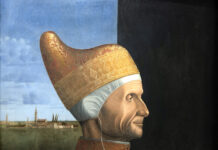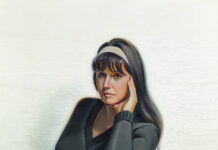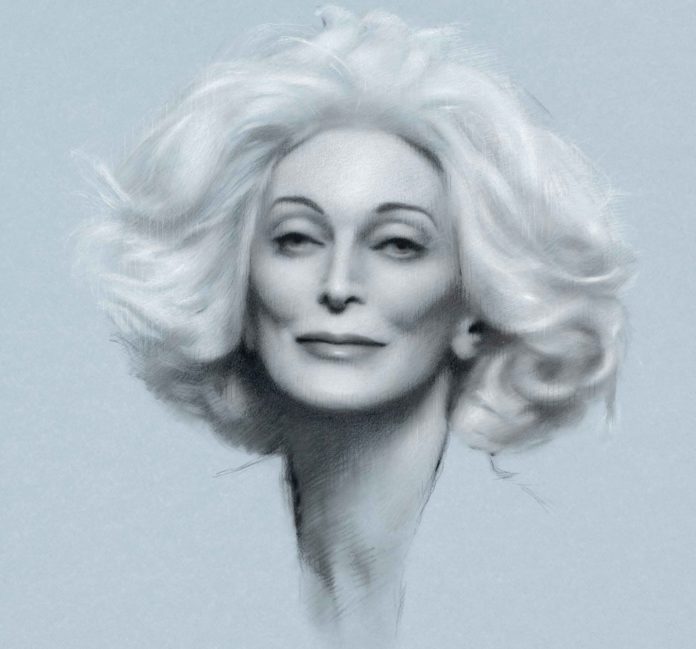
Contemporary Realism Portraits > When his muse, Carmen Dell’Orefice arrived, she said, ‘I know what you’re going to ask me and my answer is yes.’”
Read more about Graydon Parrish, who is on the faculty of the 2nd Annual Realism Live virtual art conference. Register now at RealismLive.com to save!
Meeting the Muse
BY LESLIE GILBERT ELMAN

The first time Graydon Parrish set eyes on Carmen Dell’Orefice, he knew he wanted to paint her. “I thought she was one of the most interesting people I’ve ever seen. So intriguing,” he recalls. At the time, Parrish (b. 1970) was living and painting in Amherst, Massachusetts. Carmen (as she’s known) was a celebrated fashion model living in New York City.
The Carmen that Parrish saw that day was a photograph on an advertising poster, and the prospect of meeting the real Carmen — let alone asking her to sit for a portrait — seemed unlikely. Nevertheless, the artist filed away his mental image of Carmen in what he calls his “private list of 10 people I want to paint before I die.”
After all, who was to say the two wouldn’t cross paths someday? “The wonderful thing about being an artist is you meander through different social circles,” Parrish notes. And as the tale of “when Graydon met Carmen” demonstrates, the world is indeed a small place where even unlikely connections can be made.
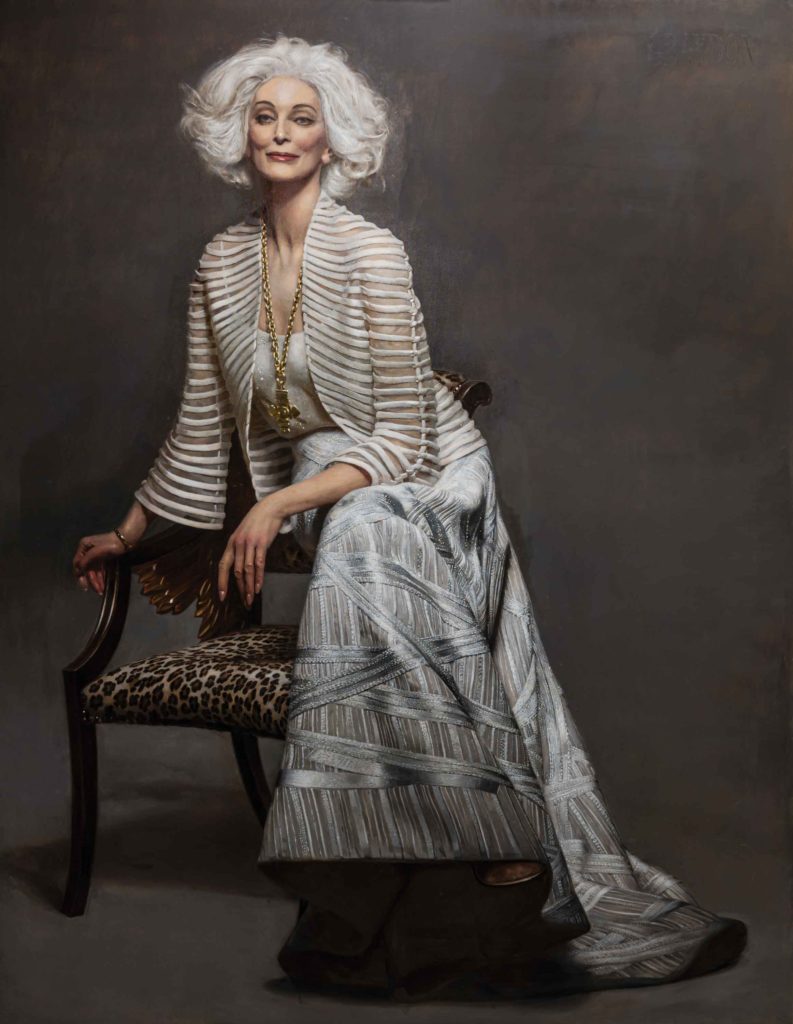
THE MODEL AS MUSE
Parrish wasn’t the first person to be so captivated by Carmen’s image. Discovered at age 13 on a Manhattan crosstown bus in 1944 (so one story goes), she was appearing in the pages of Vogue by age 15, photographed by Irving Penn, Cecil Beaton, and Horst P. Horst, among others. Her first Vogue cover was the October 15, 1947, issue, photographed by Erwin Blumenfeld.
When Carmen was in her 20s, legendary fashion editor Diana Vreeland wooed her to Harper’s Bazaar, where she modeled for photographers Lillian Bassman, Melvin Sokolsky, and perhaps most famously, Richard Avedon. By this time, Carmen’s career was well-established, and her circle of friends and professional acquaintances included Salvador Dalí, who considered her a muse. Yet Avedon was resistant to working with her, pointing out her flaws in person even as his photographs celebrated her beauty. Much later in life, Carmen would recall gradually earning Avedon’s respect as their working relationship evolved into genuine friendship.
Carmen retired from modeling when she was in her 30s, only to return in the late 1970s — her dark hair now stunningly white — and reestablish a career that continues to this day. In 2003, she appeared in an advertising campaign for Isaac Mizrahi’s fashion collaboration with Target stores. The photo of Carmen that caught Parrish’s attention was from that campaign. Just as she’d done with Dalí all those years ago, Carmen left an indelible impression on the artist’s imagination.
THE MUSE RETURNS
A few years later made a move in part to be near family and in part, he readily confesses, to escape the New England winters. It was here in Texas that he inadvertently “met” Carmen again.
“Lance Avery Morgan, a friend in Austin, was the publisher of Brilliant magazine,” Parrish says. “And there was Carmen, on the cover! I asked if there was any way he could put me in touch with her.” That was in early 2007. The publisher called New York jewelry designer Peter Martino, a longtime friend of Carmen’s, who said that if Parrish met him in New York, he might be able to arrange a meeting with Carmen.
Parrish was nervous. Carmen arrived late. But their first encounter ended encouragingly, and other casual meetings followed. “It took me about a year and half to get up the courage to ask her to sit for me,” Parrish recalls. “Finally, I invited her to dinner. When she arrived, she said, ‘I know what you’re going to ask me and my answer is yes.’”
Parrish jokes that it was his “inspiring personality” that won Carmen over, but he acknowledges that her interest in him was equally inspired by the realism style and quality of his work. Raised by his art-collector parents to appreciate 19th-century figurative art, as a painter Parrish is firmly rooted in the traditions of European academic painters. “Carmen has been painted before, and she’s been drawn by fashion illustrators, but I think this is the first time she’s been painted in a classical style with an eye to beauty rather than celebrity,” he says.
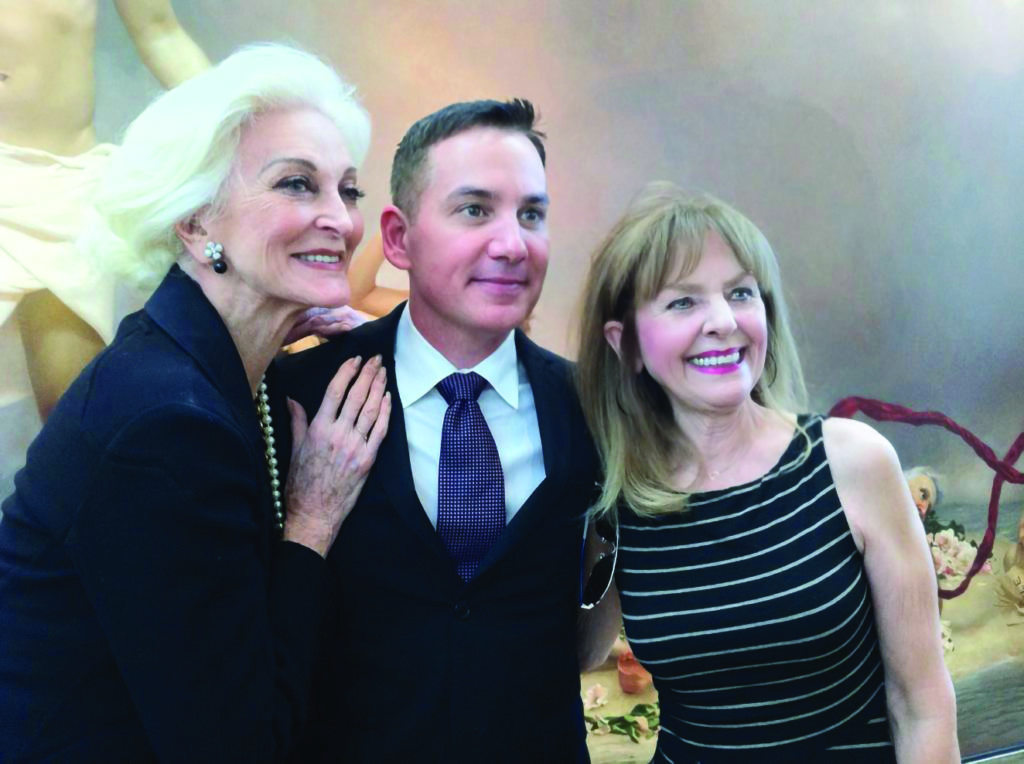
THE MUSE AS MENTOR
“One reason Carmen makes a great model is that she studied ballet,” Parrish notes. “She knows herself and how to move. Every hand gesture is articulate. She’s aware of her elegance. That is one of her secrets.”
In choosing a pose for this larger-than-life portrait, Parrish sought “something regal, like Joshua Reynolds.” And while Carmen knows instinctively how to sell a look as a model, “the challenge,” Parrish confides, “was to make her look like she feels on the inside.” Indeed, one might wonder how many times in her career — over tens of thousands of photographs — Carmen has been asked simply to be herself.
Any successful collaboration between artist and model requires underlying trust and confidence in one another. Over the course of their time in the studio — as he sketched, photographed, and painted — the bond deepened between Carmen and Parrish, fueled by their mutual love of classical art. His enthusiasm for work is infectious. When he’s not painting, Parrish is teaching art, most recently as a private mentor to students around the world in sessions online. (“I miss the in-person classes,” he says, “but I never thought I would enjoy this kind of one-on-one teaching so much.”) Carmen is a painter herself, with a studio in her home, and early in their friendship Parrish sent her some oil paints as a gift.
Blessed with insatiable intellectual curiosity, Carmen never tires of learning new things and meeting new people. In the fashion world, her friends and fans are legion and she has amassed a lifetime’s worth of stories, recollections, and mementos from people she has known. She loves fashion as an art form, not as a status symbol, and “rarely name-drops,” although Parrish notes that she chose to wear clothing by American designer Ralph Rucci for the portrait because he is one of her favorites.
“In the studio we talked, but mainly I listened to her stories,” Parrish says. “She has a lot of advice for living and I wanted to gain wisdom. She has great integrity. She’s very gracious. And she’s tenacious.”
As she approaches age 90, Carmen still appears in fashion layouts and print advertisements. She even walks in runway shows from time to time. More than once in the past few years, she’s brought Parrish as her “plus one” to fashion industry events. “I like her even more in person than I did in the abstract,” he laughs.
Parrish says he’ll paint Carmen again on a smaller scale, working from sketches and reference materials. The relationship between artist and muse is a precious one. This artist isn’t ready to let go of his muse just yet.
This article on the contemporary realism portrait painting of Carmen Dell’Orefice is an excerpt from Fine Art Connoisseur magazine, November/December 2020
About the Artist
Graydon Parrish is a realist painter living in Austin, Texas trained in and an exponent of the atelier method which emphasizes classical painting techniques. His parents, collectors of American and European nineteenth-century art, exposed him to painting at a young age and influenced his choice to pursue an academic figurative style.
Parrish attended the Booker T. Washington High School for the Performing and Visual Arts and graduated in 1988. Unable to find further classical art training, he learned of the newly formed New York Academy of Art in the summer of that year created by Andy Warhol and Stuart Pivar. There, Parrish joined other students who have become leading figures in the classical art revival, including Jacob Collins, founder of the Grand Central Academy of Art where Parrish is now an instructor. It is also at the New York Academy where Parrish met his mentor Michael Aviano, a student himself of illustrator and muralist Frank J. Reilly.
Since then Parrish has remodeled color theories by Albert Munsell and Josef Albers to fit traditional painting methods. In some ways, he and his colleagues share the reformist attitude of the Stuckist movement in England and are likewise often at odds with mainstream critical taste.
Learn How to Paint in the Style of Contemporary Realism
Parrish is on the faculty of the 2nd Annual Realism Live virtual art conference, taking place November 11-13, 2021 with a Beginner’s Day on November 20. Learn more and register now at RealismLive.com.
Discover more realism paintings and artist profiles at FineArtConnoisseur.com.

